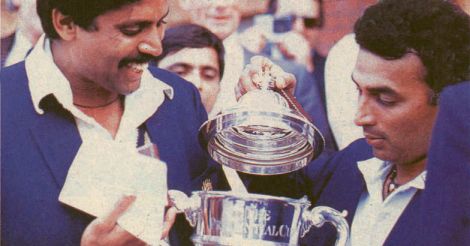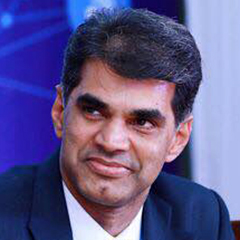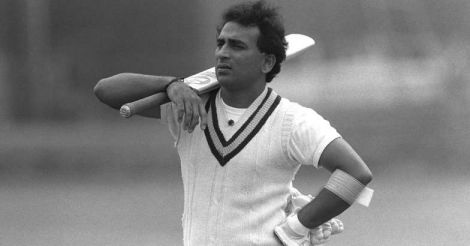The history of Indian cricket till date is replete with tales of many eminent cricketers who evolved into legends on account of their performances on the field. Normally the influence of a sporting hero is limited to his playing days but Indian cricket has been fortunate to have the presence of some champion performers who continue to motivate new entrants to the game despite hanging up their boots. Sunil Gavaskar is the doyen among such cricketing icons and he continues to enthrall the followers of the game in India by the stories of his achievements on the field, which are known to every cricket lover in the country, and his words, which are treated as the ultimate wisdom on all cricketing matters.
Multifaceted personality
Gavaskar is the owner of a many splendored personality and this has seen him lay his imprint over various fields. He is first and foremost a batsman, the best opening batsman in the history of Indian cricket and among the finest in international cricket as well. He led India and was the first skipper of the national side to step down from captaincy on a winning note, while continuing to play as an ordinary member of the squad. He made his mark as a successful writer and columnist during the 1980s when very few cricketers ventured into this arena. He was also the first among the Indian cricketers to make a smooth transition to the television commentary box. In between he also discharged the functions of administrative head of the Board of Control for Cricket in India (BCCI), for a short interregnum, at the directions of Supreme Court. Hence, it is only natural that any article which does justice to him would be a long one and hence for the sake of convenience, this writer has decided to split this effort into two - the first part focusing on Gavaskar, the batsman, and the second portion looking at his captaincy and personality.
Gavaskar made his entry into international cricket in 1971 in a rather unusual manner. The Duleep Trophy matches held during the 1970-71 season were considered as the trials for the selection of national squad to tour West Indies. However, Gavaskar did not find a place in the West Zone side, which would have put him out of contention for selection to the Indian team. But he proceeded to play the Rohinton Baria Trophy for inter-university cricket and plundered runs at will there, with scores including a triple century. This performance forced the selectors to consider his name for the tour and the rest, as they, is history. Gavaskar rewrote almost all the record books by scoring 774 runs in his first four Tests. It was not a mere coincidence that India won this series, besting the West Indians for the first time ever. This was followed by a victory over England, again, on their own turf. These wins saw followers of the game across the world look at India with a new respect even as Gavaskar established himself as the best opening batsman in contemporary world cricket, a position he held on to, till his retirement from the game in 1987.
After the phenomenal start, Gavaskar went through a relatively lean patch till June, 1974, when he could score his next Test hundred. This was against England at Old Trafford, Manchester, in conditions favoring seam and swing bowling. This innings was the sole bright spot in an otherwise disastrous tour where India were thrashed 0-3 by the hosts and even had to face the ignominy of being dismissed for a total of 42 in the second innings of second Test. He missed playing in three Tests when West Indies toured India in 1974-75 owing to a fracture in his hand, which he suffered while playing in a Ranji Trophy fixture.
At the height of his prowess
Gavaskar reached his peak as a batsman during the years from 1976 to 1981 when he could score centuries almost at will, against any attack in international cricket. His perfect technique, unflappable temperament, monumental patience and an insatiable appetite for runs saw him emerge as one of the leading run-getters in Test cricket. He knew the precise location of his off stump and used that to perfection while tackling bowlers who tried to probe in the “area of uncertainty”, which had proved to be the Achilles Heel of many a opening batsman. His head was always steady, he seldom lifted the ball from the ground and used his feet with amazing fluidity. He was an excellent judge of a run and was never short of energy for taking a quick single. He mastered the art of playing each ball on merit, to the extent that he would not look at the scoreboard when he batted. When he reached his 29th century, thus equaling the record of Don Bradman for highest number of hundreds in Test match cricket, it took his partner at the crease, Dilip Vengsarkar, to tell him that he had reached the landmark! Most importantly, he was aware of his limitations, though they were rather few in number, and believed in playing within them. Though his primary approach as a batsman was to wear the opposition down rather than pummel them into submission, there were occasions when he would unleash the array of strokes in his repertoire and stun the bowlers and spectators alike.
Till Gavaskar arrived on the scene, Indian batting line-up was hampered by the absence of an opening batsman who possessed the skill and technique to stay at the wicket and take on the challenges posed by the seam and swing bowlers in the early part of the innings. Gavaskar not only filled the void which existed since the departure of Vijay Merchant from the scene in 1951, but also worked towards building successful partnerships at the top of the order. It would be seen that Anshuman Gaekwad, Chetan Chauhan and Krishnamachari Srikkanth, the three batsmen who partnered Gavaskar for long periods in Tests, forged excellent understanding with him, which, in turn, helped to lend stability at the start of the innings. The absence of good opening batsmen had placed the top and middle order batsmen in jeopardy as they were invariably forced to tackle the ball when it was still new and hurled by bowlers who had their tail up with couple of early wickets in their bag. Gavaskar put an end to this scenario as no longer could opening bowlers find any easy wickets early in the innings. Indian middle order batting also blossomed as a consequence and the side started putting up big scores on a regular basis.
 Kapil Dev, left, and Sunil Gavaskar after India's historic win in the 1983 World Cup.
Kapil Dev, left, and Sunil Gavaskar after India's historic win in the 1983 World Cup.The period from 1975 till 1985 saw the ascent of fast bowlers in international cricket. Top sides of the time, such as West Indies and Australia, packed their sides with bowlers who were capable of hurling the red cherry at speeds exceeding 140 kms per hour. Opening the innings is never an easy task, but doing so in those days, when there were little restrictions on intimidatory bowling and protective equipment were still primitive, added the element of risk of physical injury as well. Gavaskar had to face the fastest of bowlers in their own backyards but he never wore a helmet, always depending on his technique and eye sight to play each ball on its merit. Not only did he never allow any bowler to inflict physical pain on him, at no time did it appear that he was in any danger of the ball hitting him.
Gavaskar’s versatility and mastery over his craft would be evident from the fact that he scored centuries in Test matches in all countries. However, he reserved his best for the West Indies, where he never failed to score a hundred, during each of his visits there. Even in 1983, when the West Indian speedsters were at their most hostile and he was not in the best of form, he scored a masterly ton, re-emphasising his special relationship with the cricketing nation where he made his bow in international cricket. Other than the series against England in 1971 and 1982, there was only the twin tours to Australia and New Zealand in 1980-81where he did not score a century. All the other Test series played abroad, where he was a part of, saw him score hundreds, irrespective of the conditions under which they were played or the class of opposition.
Picking out the best innings played by Gavaskar would be an onerous task as there were so many brilliant exhibitions of batsmanship, all played in trying conditions, spread through his 16 year career in international cricket. However, I would pick up three knocks played at different stages of his career that would demonstrate how he could not adapt his technique to the demands of the situation and yet maintain consistency. The first one is the innings of 220 played by him in the last Test of the 1971 series at Port of Spain, when the West Indies were going all out to win the match. Gavaskar was not only required to stay at the wicket but also score runs as the rest of the batsmen failed to cope with the West Indian attack. It is to Gavaskar’s credit that he could manage this despite battling a tooth ache and being a recent entrant to Test cricket.
The second instance is the knock of 221 played at Oval in 1979, which brought India very close to pulling off a surprise win, chasing a total of 438. The third one in his final visit to the crease in Test cricket, when, on a minefield of a wicket at Bangalore, he brought out all his experience ad skill to score 96 before being given out when India were nearing the victory post. Of the three, I would personally rate his last innings as the best, given the wicket on which it was played, the quality of the opposition and the pressure cooker situation that an India-Pakistan Test can create for the players.
Late bloomer in ODIs
Gavaskar was a rather late bloomer so far as limited overs cricket was concerned. One blip in his cricketing career was the innings he played in the opening match of the inaugural World Cup in 1975 against England, when he faced 174 balls to score an unbeaten 36. In the initial phases he was a rather reluctant learner and showed a distinct disinclination to adapt to the needs of this version of the game. However, towards the end of his career, he made amends for this and became a prolific run-getter in the shorter duration version of the game as well. His only century in One-Day Internationals came in the penultimate match of his career, against New Zealand at Nagpur, in the 1987 World Cup.
It would not be an exaggeration to say that Gavaskar carried the expectations of the whole nation on his shoulders whenever he went out to bat in a Test match. The feeling among the fans of the game in the country was that so long as he was there at the crease, there was still hope that the match could be saved. He embodied the best of middle class virtues wherein one made his way up the ladder by the dint of hard work, self discipline, dedication, commitment, frugality, all powered by an overwhelming passion to excel and come out on top. He showed the cricketing world that Indian batsmen could stand up to the fastest of bowlers and score runs without getting rattled or flustered. To the Indian cricket lover, Gavaskar was like a public sector bank, the ultimate symbol of stability and solidity, one who could be trusted to deliver at all times, without any fear of failure.
Read also: More from Vantage Point | Kapil Dev – in a league of his own
(The author is a former international umpire and a senior bureaucrat)

























 Sunil Gavaskar is the best opening batsman in the history of Indian cricket and among the finest in international cricket as well. File photo
Sunil Gavaskar is the best opening batsman in the history of Indian cricket and among the finest in international cricket as well. File photo